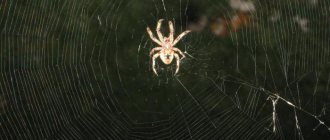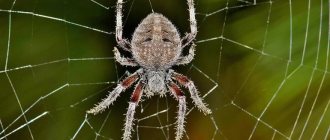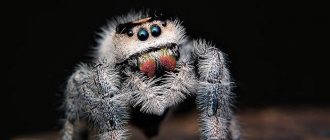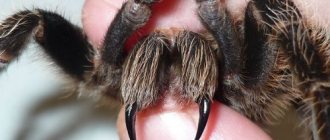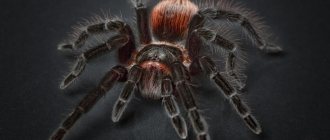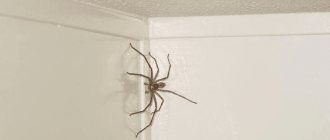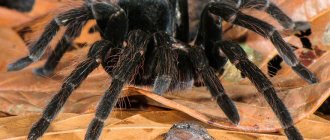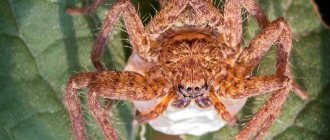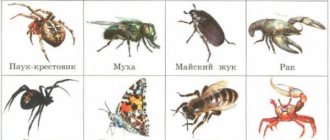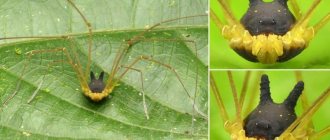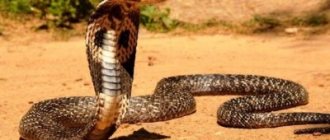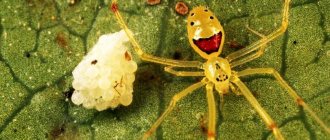The haymaker spider or centipede spider lives throughout the world. In total, there are more than 1,800 species of spiders that belong to this family. But this figure is constantly changing, because their study continues at the present time. They can differ from each other in the size of the body and legs, and can also have different colors. The most diverse species of spiders are found in the tropics, sometimes in places difficult for humans to reach. This explains the difficulty of studying them. Scientists admit that it is difficult to even describe all types of harvestmen, let alone study the features of their evolution. But the work is underway, although it is still very far from completion. On the territory of the Russian Federation you can see not many species of harvestmen, only about 60.
What does a haymaker spider look like?
The structure and appearance of the haymaker spider may vary depending on the species.
Differences may concern the spider's body. In some species it is clearly divided into the cephalothorax and abdomen, while in others this division is not so clear. The body of some species may be spherical, while others may have an elongated shape. The size of the spider's body, excluding legs, also varies greatly - from 2 to 12 millimeters. Spiders that live in the wild have leg lengths comparable to body dimensions. In those species that live near humans, the length of the legs is several times greater than the length of the body. This is their specific feature by which you can easily distinguish them. Harvesters, which can only be found at night, are black, brown, and red in color. Daytime braids are brighter in color. Among them there are orange, red, with interesting patterns or spots. Haymaking spiders that live near humans are gray or brown in color and have almost colorless limbs. The spider has 4 pairs of legs. There are the same number of pairs of eyes, but the spider sees poorly. The main organs that help you navigate the world around you are located on the limbs. The pigtail can sense the slightest air vibrations, odors and vibrations.
Along the edges of the spider's abdomen there are glands, which in times of danger can secrete a special secretion that has an unpleasant odor that scares away enemies.
Males are slightly smaller in size than females, but they have longer legs.
Types of orb weavers
Orb-weavers are those spiders that weave their web in a special way, making it especially round, vertical or flat. Of the many species, only a few live on the territory of the Russian Federation.
Spider wasp
Agryope Brunnich has an unusual striped color, for which it received the name Wasp or Tiger. She mastered the art of weaving in two different techniques. She makes special inserts in the web that shine brightly and thus attract insects.
Golden spider
He is a rare representative and meeting him is a real success. Although its size may surprise you. This species is distinguished by its web with a large number of honeycombs and its golden tint. At night the net is not visible, so even small birds can get caught in it.
Darwin's spider
This is a new species of orb-weaving spider that has the largest and most durable web. This is not an exaggeration; the web can extend up to 25 meters, often stretching over bodies of water. Despite the fact that the spider itself is small in size.
Crosses
The largest species among the orb-weaving family is the cross spider. They may differ in size, shades and lifestyle. But one thing remains constant - a strong, round web that catches many insects.
Interesting features of the haymaker spider
- If you catch a spider by the leg, it will easily come off and continue to perform convulsive movements for some time. This does not mean at all that the spider’s legs are not firmly attached to the body. The harvestman deliberately separates the limb, just as a lizard separates its tail. This anatomical feature helps him escape from enemies. When attacking, the predator first stumbles upon the spider's limbs, and then is distracted by the moving leg, which allows the spider itself to escape. Severed limbs are lost forever, which is why both in nature and in the house you can find individuals who have an unpaired number of legs.
- The web of the haymaker spider differs in shape from the web that other species of spiders weave. It does not have the traditional radial appearance. Their web is shapeless and looks like a random interweaving of threads. Such chaos is necessary to catch the victim. An insect, once in this labyrinth, tries to get out of it and gets even more stuck in the web. After the victim stops showing signs of life, the spider begins to entangle her even more and finally delivers a fatal bite. The spider can eat its prey right away, or it can put it off for later.
- When a spider senses a threat to its life, it begins to vibrate strongly, shaking its webs so that they are clearly visible and potential prey does not fall into them. If, nevertheless, an insect is caught in the web, which remains dangerous for the spider, it can gnaw through several threads so that the victim can free itself.
Description of the orb weaver family
Spiny orb spider.
Orb-weaving spiders are considered the best craftsmen in weaving trapping webs. The web of this type of spider is very plastic and elastic. If you stretch it 5 times, it still won’t tear and will return to the same shape.
The females, and they are the ones who weave the web, create a real masterpiece. Their spiral networks are engineering marvels. The spider creates one large web quickly, within an hour.
Where are the networks located?
Orb weaver in a web.
The web primarily serves one purpose - to catch prey for consumption. This is a trap, near or in the center of which the spider waits for its food.
Orb-weaving spiders hunt insects, so they place their webs in places where they live. The place where the spider settles is between plants. Moreover, the whole structure begins with one web, which the spider weaves and launches so that in the wind it catches on another plant.
How a web weaves
When such a network is launched, the spider makes a second network in parallel, a kind of bridge, which helps to descend. This is the basis of the web, from which dry radial threads then emerge.
Thin threads are then added to create a spiral-shaped honeycomb. It has many turns and is very thin, unnoticeable. Dry spirals are made for animals to climb over the web, but not stick to it.
Lifestyle
Most species hunt at night.
During the day they hide in the shade, hiding from sunlight. Sometimes they can be seen on the walls of buildings, frozen with their legs splayed to the sides. Pets hide in apartments in secluded places - in corners, behind furniture, in the bathroom. They can weave their web in places where it is difficult to reach during cleaning - under the ceiling or near windows. Spiders' webs are very large and can wrap around entire corners. One spider can weave around one corner and then move to the next. Spiders are very shy. If an enemy appears, the spiders flee from him, developing a fairly high speed.
Diet of harvest spiders
The predominant menu of spiders consists of insects - flies, mosquitoes, beetles, aphids, midges, ticks and others.
Haymakers eat these insects not only in nature, but also in residential areas. Therefore, house spiders are beneficial because they exterminate pests that get into the apartment and prevent them from reproducing. How does a haymaker hunt? When the insect cannot dodge the spider, it attacks it and bites it, injecting poison. Once the victim dies, the spider injects it with a special digestive enzyme designed to soften the victim's body. After the prey becomes soft, the spider eats it. If the haymaker is not very hungry, then he can take away the remains of the catch and hide it for future use. A very hungry spider may not wait for the victim to fall into its web and rush to the prey as soon as it is close to the web. If the insect turns out to be larger and stronger than the spider, then in this case victory may not be on its side.
In the winter season, when insects become scarce, spiders often have to remain hungry. In order not to die of hunger, spiders found a way out - to eat their relatives, as well as their eggs. Hunting other spiders is quite dangerous. Having lured another spider out of the web, he attacks him, but the outcome of such a fight is unknown.
Increase in spider population
Spiders reach sexual maturity after one year.
During this year they molt five times. Only after this they begin to produce a special secretion and look for a female for fertilization. Having found the female's web, the spider steps on it and begins to shake, thereby attracting the female's attention. When the female comes out, he begins to feel her with his legs, making it clear that he is ready to begin mating. Otherwise, the female may eat it. Immediately after the mating process ends, the spider must quickly run away otherwise the female will eat it. If mating lasted too long, the male became weak and could not escape, but the female still eats him. During his life, a male manages to fertilize only 2-3 females, since he does not live long, on average about a year. Females live for about 3 years because no one tries to eat them after fertilization. There are not so many eggs - 2-3 to 5 dozen. The female does not weave a cocoon. She collects the entire clutch with a net and carries it with her in her jaws. Several eggs may fall out of the net during this process and will not develop further. After a few weeks, the eggs hatch into spiderlings. Their fate is usually different. The weakest ones, who cannot even break through the egg and get out of it, are eaten by the spider. The rest develop very quickly, and soon the first molt occurs.
Shedding
- This is a painful process for spiders. During it, they shed their cover, their legs become short, and their bodies become transparent. While the spiderlings are growing and molting, they are with their mother. She continues to carry them with her in a net specially woven for this purpose.
Lift device
A fishing spider is a device in the form of a rectangle with a mesh stretched over a metal frame. To use it or make it yourself in the future, you need to understand the structure of the product.
- Cross. The crosspiece is the basis of the product. It is made of pipes with cavities. The pipes are welded perpendicular to each other.
- 4 rods. Necessary to give the device its shape. At one end they are inserted into the corners of the canvas, at the other - into the cross.
- Net. A mesh or thin fabric is stretched over a rope or fishing line attached to rods. The size of the canvas depends on the size of the lift. For the dwarf, a side length of 1 meter is used.
- Rope. Attached to the crosspiece. The length depends on the distance over which you plan to throw the tackle. The main requirement is tensile strength.
- Pole. The length of the pole is also taken based on the distance over which the lift will be thrown. On average it is 2-3 meters. The pole should be strong and light.
How to deal with hay spiders?
Dealing with haymakers is not difficult. In general, these spiders are harmless and do not cause any harm to humans. An obvious disadvantage of having a spider in an apartment can be its webs. This is not aesthetically pleasing and may annoy people who want to get rid of spiders. In this case, the fight against them should take place in two stages:
Keeping the house clean
- a spider can get into the house through cracks or ventilation ducts, so it is necessary to seal even the smallest cracks and install ventilation grilles with small cells. It is recommended to install nets on windows;
- if the apartment does not have blinds or dark curtains, then the bright light will attract flies, which spiders like to feed on, so it is best to create partial shade in the apartment so that flies flying into the apartment do not provoke the appearance of spiders in it;
- Daily cleaning serves as a preventive measure against the appearance of spiders in the house. Using a broom or brush, you need to carefully go through all the places where spiders can hide;
- if a web is found, it is best to remove it together with the spider;
- haymakers prefer warmth and dryness, so air humidification prevents their appearance;
- there is no food for the spider, and there are no spiders themselves; if there are no insects in the apartment that serve as food for harvesters, then they will not settle here.
Repelling them with smells
Repelling them with smells will help remove spiders from your home.
They really don't like the smells of essential oils such as mint, eucalyptus, and tea tree. If you periodically spray these substances in the apartment, the spiders will go to another room. Harvesting spiders
- absolutely not dangerous, and sometimes even useful inhabitant of the house. They fight other, more unpleasant insects that may settle in the apartment. After the destruction of spiders, harmful insects can proliferate greatly. Therefore, one or two spiders will not hurt anyone. The main thing is to make sure that there are not too many of them, otherwise cobwebs will hang from all corners.
